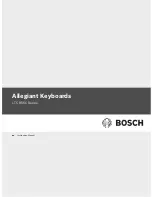
KDFX Reference
KDFX Algorithm Specifications
10-21
Pre Dly
Introducing predelay creates a gap of silence between that allows the dry signal
to stand out with greater clarity and intelligibility against the reverberant
background. This is especially helpful with vocal or classical music.
Build Time
Similar to predelay, but more complex, larger values of BuildTime slow down
the building up of reverberation and can extend the build up process.
Experiment with BuildTime and BuildEnv and use them to optimize the early
details of reverberation. A BuildTime of 0ms and a BuildEnv of 0% is a good
default setting that yields fast arriving, natural reverberation.
Build Env
When BuildTime has been set to greater than about 80ms, BuildEnv begins to
have an audible in
fl
uence on the early unfolding of the reverberation process.
For lower density reverberation that starts cleanly and impulsively, use a
setting of 0%. For the highest density reverberation, and for extension of the
build up period, use a setting of 50%. For an almost reverse reverberation, set
BuildEnv to 100%. You can think of BuildEnv as setting the position of a see-
saw. The left end of the see-saw represents the driving of the reverberation at
the earliest time, the pivot point as driving the reverberation at mid-point in the
time sequence, and the right end as the last signal to drive the reverberator. At
settings near 0%, the see-saw is tilted down on the right: the reverberation starts
abruptly and the drive drops with time. Near 50%, the see-saw is level and the
reverberation is repetitively fed during the entire build time. At settings near
100%, the see-saw is tilted down on the left, so that the reverberation is hit softly
at
fi
rst, and then at increasing level until the end of the build time.
LFO Rate and Depth
Within the reverberator, the certain delay values can be put into a time varying
motion to break up patterns and to increase density in the reverb tail. Using the
LFO Rate and Depth controls carefully with longer decay times can be
bene
fi
cial. But beware of the pitch shifting artifacts which can accompany
randomization when it is used in greater amounts.
Diffusion
Within the reverberator, the Diffusion control can reduce the diffusion provided
some of the all pass networks. While the reverb will eventually reach full
diffusion regardless of the Diffusion setting, the early reverb diffusion can be
reduced, which sometimes is useful to help keep the dry signal "in the clear."
Содержание K2661
Страница 18: ...2 4 LFOs LFO Shapes...
Страница 34: ...3 16 DSP Algorithms...
Страница 54: ...5 4 MIDI Note Numbers Note Numbers for Percussion Keymaps...
Страница 72: ...7 10 System Exclusive Protocol K2661 System Exclusive Implementation...
Страница 82: ...9 4 Upgrading Sample Memory Choosing and Installing a SIMM for K2661 Sample Memory...
Страница 334: ...10 252 KDFX Reference KDFX Algorithm Specifications...
Страница 340: ...11 6 Glossary...
Страница 382: ...12 42 Triple Modular Processing Alphanumeric Buttonpad Entries for DSP Functions...
Страница 392: ...B 6 SysEx Control of KDFX MSB and LSB...
Страница 442: ...D 20 Contemporary ROM Block Objects Controller Assignments Contemporary ROM Block...
Страница 490: ...H 12 General MIDI Standard Mode Controller Assignments...
Страница 492: ...I 2 Live Mode Objects Live Mode Programs...
Страница 498: ...K2661 Musician s Reference Index...
Страница 500: ......
















































